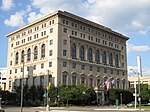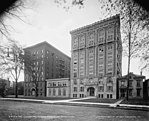Ford Field

Ford Field is a domed American football stadium located in Downtown Detroit. It primarily serves as the home of the Detroit Lions of the National Football League (NFL), the Michigan Panthers of the United Football League (UFL), the Mid-American Conference championship game, and the annual Quick Lane Bowl college football bowl game, state championship football games for the MHSAA, the MHSAA State Wrestling Championships, and the MCBA Marching Band State Finals, among other events. The regular seating capacity is approximately 65,000, though it is expandable up to 70,000 for football and 80,000 for basketball. The naming rights were purchased by the Ford Motor Company for $40 million over 20 years; the Ford family holds a controlling interest in the company, and they have controlled ownership of the Lions franchise since 1963.
Excerpt from the Wikipedia article Ford Field (License: CC BY-SA 3.0, Authors, Images).Ford Field
Saint Antoine Street, Detroit Midtown
Geographical coordinates (GPS) Address External links Nearby Places Show on map
Geographical coordinates (GPS)
| Latitude | Longitude |
|---|---|
| N 42.34 ° | E -83.045555555556 ° |
Address
Ford Field
Saint Antoine Street
48226 Detroit, Midtown
Michigan, United States
Open on Google Maps









